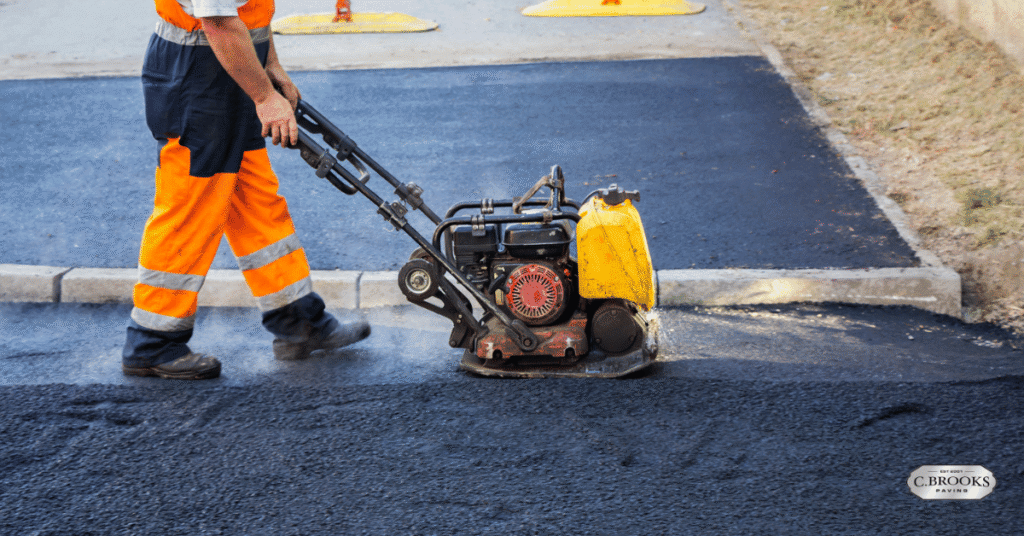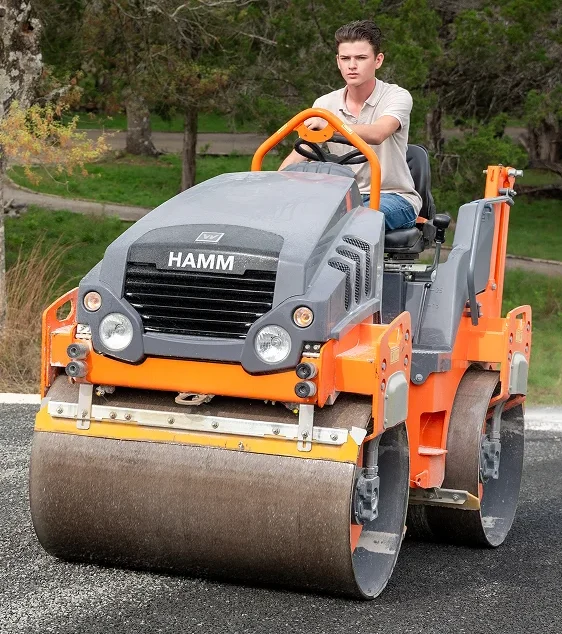When you drive down a smooth country road or pull into a clean, textured driveway in Texas, there’s a good chance you’re traveling on chip seal paving. This time-tested method delivers a durable, affordable surface that holds up beautifully against Texas heat and heavy use.
At C. Brooks Paving, our team has spent four generations perfecting the craft of chip seal paving in Bulverde, TX, and throughout South Texas. In this detailed guide, we’ll explain exactly how chip seal paving works step by step and why it’s one of the smartest paving investments for both homeowners and municipalities.

What Is Chip Seal Paving?
Chip seal paving also known as tar and chip paving is a method that combines hot liquid asphalt with layers of crushed stone. The result? A textured, skid-resistant surface that’s cost-effective and long-lasting.
Instead of applying a thick layer of asphalt like in traditional paving, the chip seal method uses a thin layer of asphalt binder followed by a layer of small stones or “chips.” These are then rolled and compacted into the surface, creating a natural-looking, rugged, yet durable pavement.
Why Texans Love It:
- Lower cost than full asphalt paving
- Excellent traction and water resistance
- Quick installation and curing
- Perfect for rural roads, long driveways, and private properties
Why Homeowners & Cities in Texas Choose Chip Seal
Across Bulverde, the Hill Country, and South Texas, chip seal paving has become the go-to choice for both homeowners and county road projects.
Whether it’s a ranch road, a driveway, or a neighborhood access road, chip seal provides a strong surface that withstands high temperatures, stormwater, and continuous vehicle traffic.
Here’s why it fits the Texas landscape so well:
- Durability: Handles both sun and sudden rainstorms with ease.
- Cost Savings: Around 30–40% less expensive than asphalt paving.
- Rural Charm: Offers a natural, stone-finished look ideal for country driveways.
- Low Maintenance: Only occasional sweeping and resealing required.
It’s a method proven over decades on Texas highways and C. Brooks Paving brings that same highway-grade quality to residential and commercial projects.
Materials Used in Chip Seal Paving
Every chip seal project relies on three main components, each carefully selected for performance and longevity:
1. Asphalt Binder (Emulsion or Tar)
This is the sticky, oil-based layer that acts as the glue. It’s sprayed evenly over the surface using a calibrated distributor truck.
2. Crushed Aggregate Chips
These small stones typically granite or limestone are applied over the hot binder. Their rough texture gives chip seal its signature grip and rustic appearance.
3. Specialized Equipment
From distributor trucks to chip spreaders and pneumatic rollers, professional equipment ensures even coverage and proper compaction essential for long-term durability.
At C. Brooks Paving, we source premium materials from trusted South Texas suppliers, ensuring every project meets both strength and visual appeal standards.
Step-by-Step: How Chip Seal Paving Works
Let’s break down the chip seal paving process that our experienced crew follows across Bulverde and the Hill Country.
Step 1: Site Preparation and Grading
Every successful paving project begins with a solid foundation.
We start by grading and compacting the existing surface, removing debris, filling potholes, and ensuring proper water drainage. A clean, stable base is crucial for adhesion and longevity.
Step 2: Applying the Asphalt Binder
Next, we apply a hot liquid asphalt binder using a high-pressure distributor truck. This ensures an even, consistent coat across the surface forming the sticky base layer that will hold the chips in place.
Step 3: Spreading the Aggregate Chips
Immediately after the binder is applied, crushed stone chips are spread uniformly across the surface. Timing here is key the binder must still be hot and tacky to secure each chip properly.
Step 4: Rolling and Compaction
Our crew then uses a heavy pneumatic roller to embed the chips firmly into the asphalt layer. This compaction locks the stones into place and creates the durable, rough-textured surface chip seal is known for.
Step 5: Sweeping and Curing
After compaction, we allow the surface to cure for a short period. Then, any loose chips are swept away to ensure a clean finish and prevent tracking.
Step 6: Optional Second Layer or Sealcoating
For high-traffic areas like county roads or commercial parking lots, we may apply a second chip seal layer or a protective sealcoat for added durability and smoother finish.
Step 7: Final Inspection
Finally, our crew performs a detailed inspection checking the evenness, chip distribution, and edge sealing to ensure the project meets C. Brooks Paving’s high standards of precision and quality.
Maintenance and Lifespan
One of the biggest advantages of chip seal paving is its low maintenance and long service life. With proper care, a chip seal surface can last 7–10 years or even longer.
To keep it looking and performing its best:
- Sweep off loose gravel occasionally.
- Reseal the surface every few years if desired.
- Keep drainage clear to prevent pooling water.
Compared to full asphalt paving, chip seal requires minimal upkeep, making it ideal for large properties or rural roads that need dependable performance without heavy maintenance costs.
Common Myths About Chip Seal Paving
Despite its growing popularity, a few misconceptions still surround chip seal paving. Let’s clear them up:
Myth 1: “It’s only for rural roads.”
Reality: Chip seal works great for residential driveways, ranch roads, and even parking lots. It’s versatile and attractive.
Myth 2: “It’s messy and rough.”
Reality: With professional installation and proper rolling, excess chips are minimal and surfaces remain smooth and safe.
Myth 3: “It doesn’t last long.”
Reality: A properly applied chip seal surface can easily rival asphalt in durability especially in Texas climates.
When installed by professionals like C. Brooks Paving, chip seal is a proven, reliable surface solution.
Cost Factors for Chip Seal Paving in Texas
Chip seal is one of the most cost-efficient paving methods available. Several factors influence the final price:
- Project size: Larger areas benefit from economies of scale.
- Number of layers: Single vs. double chip seal affects cost.
- Aggregate type: Premium stone chips or decorative finishes may increase price slightly.
- Base preparation: Grading, drainage, and patch repair requirements.
Even with these variables, chip seal paving typically costs significantly less than asphalt offering impressive longevity for the price.
If you’re seeking a budget-friendly, long-lasting paving solution for your Bulverde driveway, ranch road, or commercial lot, chip seal is the perfect fit.
Why Choose C. Brooks Paving
For over four generations, C. Brooks Paving has built a reputation across South Texas for integrity, precision, and quality craftsmanship.
Our services go beyond chip seal paving we specialize in:
- Asphalt paving in Bulverde TX
- Driveway paving for homes and ranches
- Parking lot paving for local businesses
- Sealcoating and crack repair
- Pothole and road maintenance services
From small residential driveways to major municipal roadways, we bring the same attention to detail and commitment to excellence to every project.
✅ Local Expertise: We understand Texas soils and climates.
✅ Proven Quality: 5-star rated, trusted by local homeowners and contractors.
✅ Family-Owned: Four generations of paving mastery.
✅ Full Service: From asphalt paving to tar and chip seal roads.
Conclusion: A Proven Texas Tradition
Chip seal paving isn’t just a budget alternative it’s a smart, time-tested method that delivers lasting value, strength, and beauty to any property.Whether you’re paving a long country driveway, upgrading a parking lot, or restoring a rural road, C. Brooks Paving brings you expert craftsmanship backed by decades of experience.





